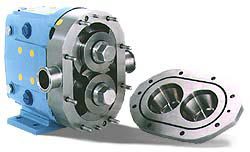How do We Specify the Optimal Pump for a Sanitary Metering or Dosing System?
In previous posts we have gone over different aspects of sanitary metering and dosing systems including defining the criteria for a system, proper use of balance tanks, and sanitary flow meter selection. Today we will concentrate on another key component of most systems, the sanitary metering pump.
We have a large toolbox of pumps to choose from for our sanitary metering systems. These include Waukesha ECP pumps, Quattroflow quaternary diaphragm, Masterflex peristaltic, Axiflow twin screw, and Graco double diaphragm and sanitary piston pumps. So how do we decide which is the right pump for the specific metering application? We have 6 major pieces of criteria we look at.
Here are the key factors we look at when specifying a sanitary metering pump:
- Range of flow rates (minimum and maximum)
- Differential Pressure requirements
- Rheology
- Seal and seal support requirements
- General product compatibility
- Accuracy requirements
- Cost
Let’s take a closer look at these individually.
Flow Rates
For very precise, low flow rates, several of these pumps can be eliminated. The piston, diaphragm and twin screw pumps are not designed to pump efficiently at fractions of a liter per minute. Quattroflow, peristaltic, and in some cases, Waukesha PD pumps can. Conversely, peristaltics do not do well in high flow applications or differential pressure applications. Piston and double diaphragm pumps also are normally not suited for flow rates over 100gpm. For high flow rates (100gpm+) we normally look at Waukesha PD pumps, Axiflow twin screw, or Quattroflow diaphragm pumps in pharmaceutical applications.
Pressure Requirements
If you we rate these metering pumps for pressure output capabilities, lowest to highest, it would go peristaltic, Quattroflow, double diaphragm, twin screw, sanitary lobe then piston pumps.
Rheology
The biggest rheological issues we are normally concerned with are viscosity and shear sensitivity. Here is an overview of how these sanitary metering pumps rate.
- Peristaltic: Cannot pump higher viscosities but they are gentle on shear sensitive products
- Quattroflow: Similar to peristaltics, these do not do well with viscosity but are extremely gentle on the product. Their low pulsation, volumetric efficiency, and accuracy come from the pumps short stroke length. The short stroke length also limits the pump to products with a viscosity of approximately 200 cps.
- Double Diaphragm: When sized properly these can handle higher viscosities and are considered low shear pumps. They are also uniquely suited for drum unloading and batching applications.
- Twin Screw: Excellent for both shear sensitivity and viscosity. Sanitary twin screw pumps, when properly sized also handle particulate well.
- Sanitary ECP PD Pumps: Excellent with high viscous liquids, if sizes properly they can be relative low shear
Seal Requirements
The Quattroflow, peristaltic and double diaphragm pumps have no mechanical seals. Twin screw, piston and Waukesha sanitary pumps do. A broad choice of mechanical seals are available for these. But if maintaining absolute sterility is an issue, the non-seal pumps may be preferable.
Accuracy
The accuracy of the actual pump may or may not be an issue depending on how the rest of the sanitary metering system is configured. As a general rule of thumb, maintaining consistent accuracy in a metering pump is a good thing. By design, if properly maintained the Quattroflow, Waukesha PD and piston pumps are consistently accurate, with exceptionally low slip. The accuracy of peristaltic and double diaphragm pumps will degrade as their tubing and/or diaphragms wear.
So that is the matrix we start with when specifying a pump for a sanitary metering or dosing systems. Like most things in life, there are a lot of tradeoffs with each pump. Our goal is to work with our clients and help them define the critical aspects of their systems and what quality by design features they want to incorporate into their system. Sometimes, none of these pumps will work and we will do our research and come up with something else.
Besides the criteria described above, we have to also look at the system as a whole before specifying a bill of materials for the metering pump or any other part of the system. This includes the meters, instrumentation, and controls. We do not take a cookie cutter approach to this. We look at each system as a standalone project and try to engineer the best solution for that specific application.
You’re probably wondering- why didn’t we address the economics of each technology? For most people cost is a big deal. It is for us as well. Providing as the greatest value to our customers is paramount in all of the systems we design and build. We always look for the most cost effective solution that meets our customers goals. We wouldn’t have been in business over 100 years if we didn’t.
As always, if you have any questions or comments on this post or any others, contact us. We are here to help.










